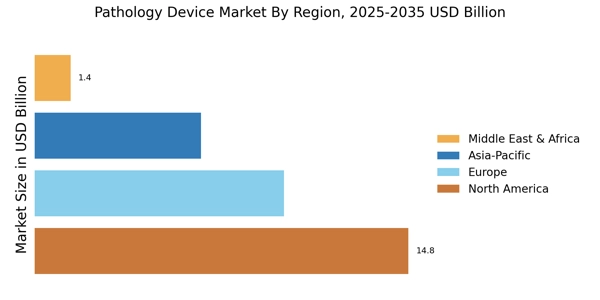Emphasis on Research and Development
The Pathology Device Market is characterized by a strong emphasis on research and development, which is crucial for driving innovation and improving diagnostic capabilities. Companies are investing heavily in R&D to develop new pathology devices that meet the evolving needs of healthcare providers and patients. This focus on innovation is leading to the introduction of novel technologies, such as molecular diagnostics and next-generation sequencing, which are transforming the landscape of pathology. As research initiatives continue to expand, the Pathology Device Market is expected to benefit from the introduction of cutting-edge devices that enhance diagnostic accuracy and efficiency.
Rising Incidence of Chronic Diseases
The Pathology Device Market is significantly influenced by the rising incidence of chronic diseases, such as cancer and cardiovascular disorders. As the prevalence of these diseases continues to escalate, there is an increasing demand for effective diagnostic tools that can aid in early detection and treatment. For instance, cancer diagnostics alone is expected to account for a substantial share of the pathology device market, with estimates suggesting that the market could reach several billion dollars by the end of the decade. This trend underscores the critical role that pathology devices play in managing chronic diseases, thereby propelling the growth of the Pathology Device Market.
Growing Demand for Point-of-Care Testing
The Pathology Device Market is witnessing a growing demand for point-of-care testing solutions, which offer rapid and accurate diagnostic results at the site of patient care. This trend is driven by the need for timely decision-making in clinical settings, particularly in emergency and critical care situations. Point-of-care devices are becoming increasingly sophisticated, incorporating advanced technologies that allow for comprehensive testing with minimal turnaround time. The market for these devices is expected to expand significantly, as healthcare providers seek to enhance patient outcomes through immediate diagnostics. Consequently, the Pathology Device Market is likely to see a shift towards more portable and user-friendly testing solutions.
Technological Advancements in Pathology Devices
The Pathology Device Market is experiencing a surge in technological advancements, particularly in imaging and diagnostic tools. Innovations such as high-resolution digital imaging systems and automated slide scanners are enhancing the accuracy and efficiency of pathology diagnostics. The integration of advanced software solutions, including artificial intelligence algorithms, is streamlining workflows and improving diagnostic precision. According to recent data, the market for digital pathology devices is projected to grow at a compound annual growth rate of over 10% in the coming years. This growth is indicative of the increasing reliance on technology to facilitate faster and more reliable diagnostic processes, thereby driving the overall Pathology Device Market.
Increased Investment in Healthcare Infrastructure
The Pathology Device Market is benefiting from increased investment in healthcare infrastructure across various regions. Governments and private entities are allocating substantial resources to enhance laboratory capabilities and improve diagnostic services. This investment is particularly evident in emerging markets, where the demand for advanced pathology devices is on the rise. Enhanced funding is facilitating the acquisition of state-of-the-art pathology equipment, which is essential for accurate diagnostics and patient care. As a result, the Pathology Device Market is poised for growth, with projections indicating a robust expansion in the coming years as healthcare systems evolve to meet the needs of diverse populations.


















Leave a Comment